Locust Tree Varieties | Popular Types & Species With Pictures
Among the twenty different varieties of locust trees, there are a few that are more common. These include honey locust, black locust, and bristly locust. For thornless varieties, go for honey locusts.
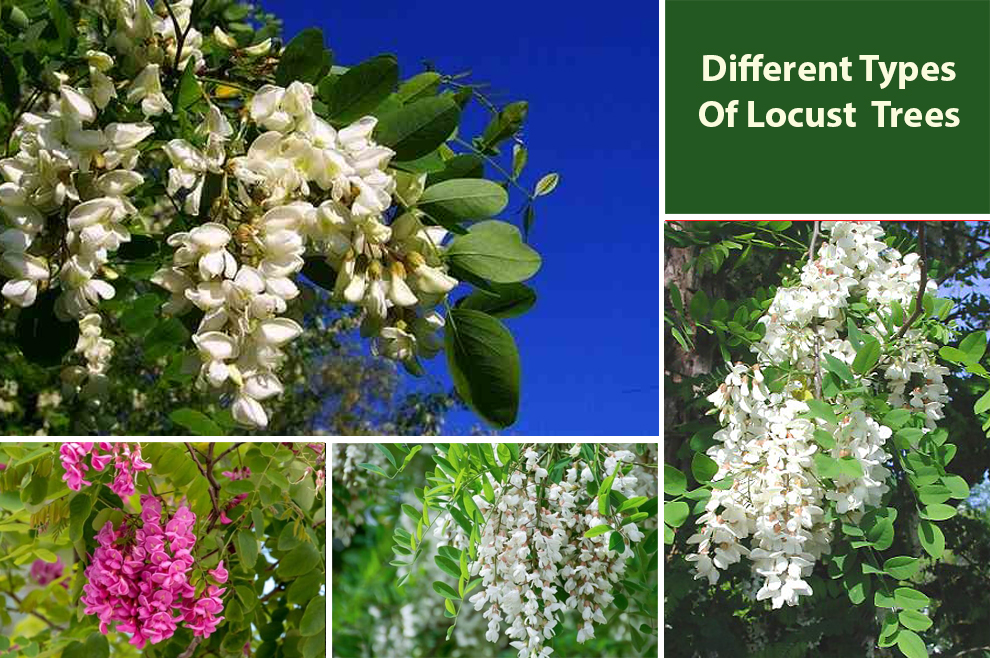
The locust trees are known for their fragrant flowers, beautiful foliage, and hardy nature. Broadly, there are twenty recognized types of locust trees in the Robinia genus. These include popular varieties, such as New Mexican Locust, Bristly Locust, Honey Locust, and Black Locust.
They boost the beauty of a landscape with their captivating looks. They are mainly found in North America and are favored for their ability to endure challenging environmental conditions, making them a sight in suburban and urban settings.
Be it the Black Locust’s striking white flowers or the Honey Locust’s fern-like leaves, all locust tree varieties bring their distinct charm to the streetscapes, parks, and gardens, enriching the green spaces across the continent.
Locust Tree Identification
| Locust tree bark | Rough and deeply furrowed |
| What does a locust tree leaf look like | Pinnately compound, with small leaflets arranged along a central stalk and the leaflets are often oval or elliptical in shape. |
| Locust tree fruit | Legume-like fruits or pods that are elongated and contain seeds. They are often brown and have a slightly curved shape. |
| Locust tree trunk | Sturdy and characterized by deep ridges and furrows with a dark brown or grayish-brown |
| Are locust tree flowers edible? | Yes, but not all species have edible flowers. |
| Locust tree thorn | Most species have thorns that serve as a defense mechanism |
Different Types of Locust Trees
This guide will take you through the different varieties of locust trees. You can read about them to decide which one is best suited for your landscape.
A. Honey Locust Tree
| Scientific Name | Gleditsia triacanthos |
| Hardiness Zone | Three through Nine |
| Thorns? | Yes |
| Flowers | Greenish-white, small flowers |
| Mature Size | 40 to 70 feet tall |
Native to North America, Honey Locust Tree is a deciduous tree known for its flat, long seed pods and thorny branches. They have an irregular-shaped spreading, open crown that grows up to eight inches.
Its leaves are pinnately compounded and have multiple leaflets arranged in pairs along the central axis. While most species have thorns, you can find cultivated thornless varieties too.
These thornless species are preferred for landscaping purposes to avoid any potential hazard. There are several different types of locust trees in this category. Below are some of them:
Skyline

It is a thornless honey locust cultivar with a columnar, upright growth habit. It grows between 40-70 feet and has pinnately compound leaves comprising 15-25 oval, bright green leaflets that turn golden yellow in autumn.
These are adaptable trees and thrive in different soil conditions. They are known for offering filtered shade and landscaping and serve as a vertical accent in residential and urban settings.
Shademaster
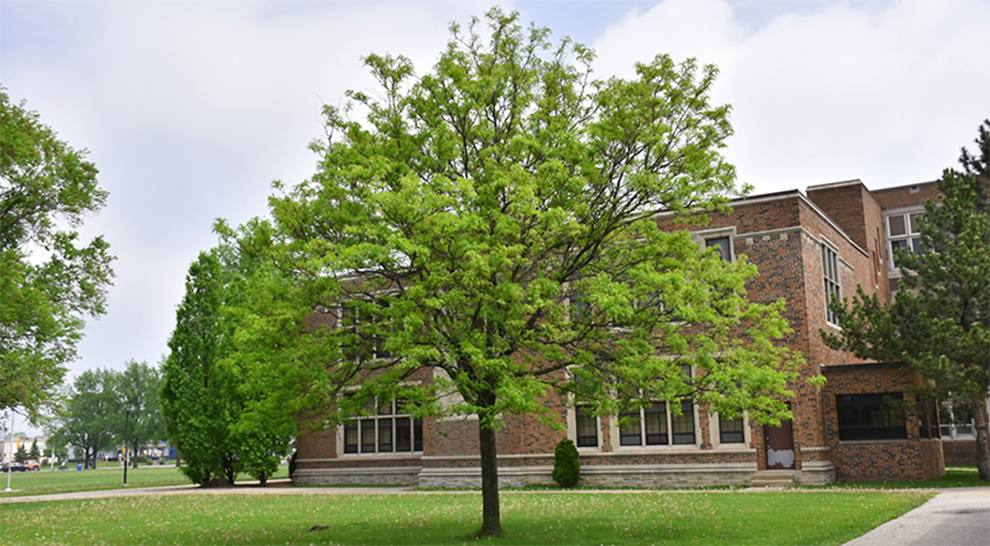
It is a highly sought-after variety for lawns. It has green leaves that turn golden-yellow in autumn, and its rounded shape makes it visually appealing. What sets it apart is its wide-spaced branches and small leaves.
It allows for a partial shade sans blocking the growth of the grass or the plant underneath. Their hardiness makes them resilient to wind damage and ice storms.
Imperial

It is one of the highly valued locust tree species cherished for its delicate fern-like foliage, creating a rounded crown with bright green leaves that transition to a vibrant yellow in autumn.
It has few seed pods and is a low-maintenance addition to the landscape, providing texture and shade. Imperial Locust is best for sidewalks, parking lot islands, and residential streets.
Sunburst honey locust tree
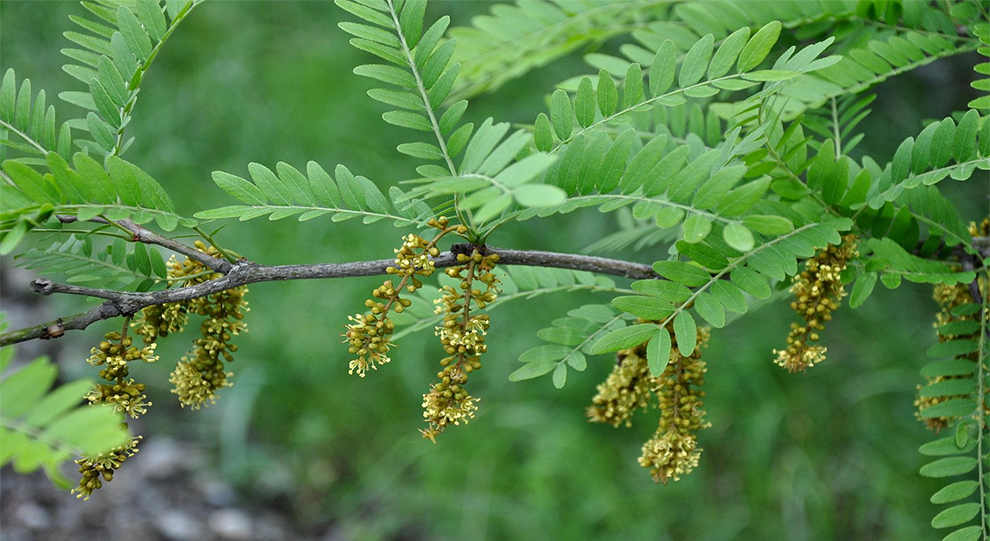
It is a thornless variety with distinct horizontal branching and a spreading crown. Its shallow root system can cause curb and sidewalk heaving when not given ample space.
Despite lacking thorns and messy pods, the Sunburst locust experienced declining popularity because of heavy pest and disease issues.
But it is a favored selection for landscapes because of its small leaves that let dappled light and the ability to grow grass beneath.
Thornless honey locust
The thornless honey locust tree offers more than just dappled shade with its delicate foliage. It is highly adaptable and can withstand different soil conditions. Further, it can also endure road salt and drought. The tree puts forward a beautiful yellow color in the fall, but it is overly employed in suburban and urban landscapes because of its popularity.
B. Black Locust Tree
| Scientific Name | Robinia pseudoacacia |
| Hardiness Zone | Varies depending on the specific location, but generally 4-9 |
| Thorns? | Yes |
| Flowers | Fragrant white flowers in clusters, which are attractive to pollinators like bees |
| Mature Size | 40-60 feet with 30 feet spread |
Also called the Robinia tree, Black Locusts are fast-growing locust tree varieties that thrive in different soil conditions, including poor soil quality. They can endure drought and are mostly found along woodlands and riverbanks.
The black locust tree’s wood is hard and robust, making it viable for different purposes, including firewood and crafting. This tree has an invasive potential and can spread via suckers. Thus proper maintenance is vital to prevent it from dominating the space.
Some subtypes of black locust trees are:
Frisia Black Locust
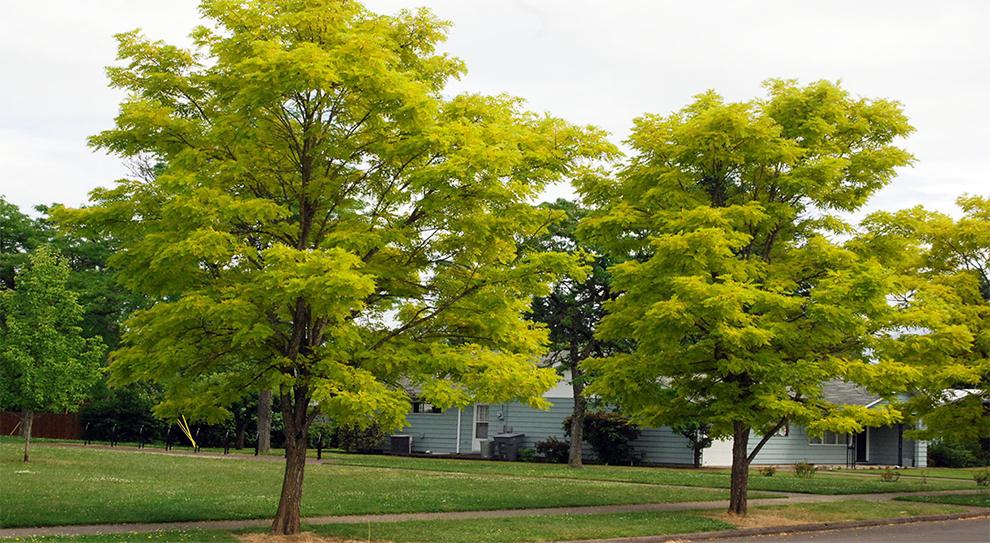
Scientifically called the Robinia pseudoacacia Frisia, the Frisia black locust is a highly sought-after variety known for its decorative beauty. It has vibrant yellow foliage that may occasionally shift to lime green, creating a visually appealing image.
Purple Robe Black Locust
Robinia pseudoacacia Purple Robe, the Purple Robe black locust, is known for its ornamental value. It boasts stunning purple and pink flowers in spring. This purple street tree offers excellent shade and produces a captivating aesthetic. Its leaves have a purple hue during growth but mature into a deep bronze color.
Twisty Baby Black Locust
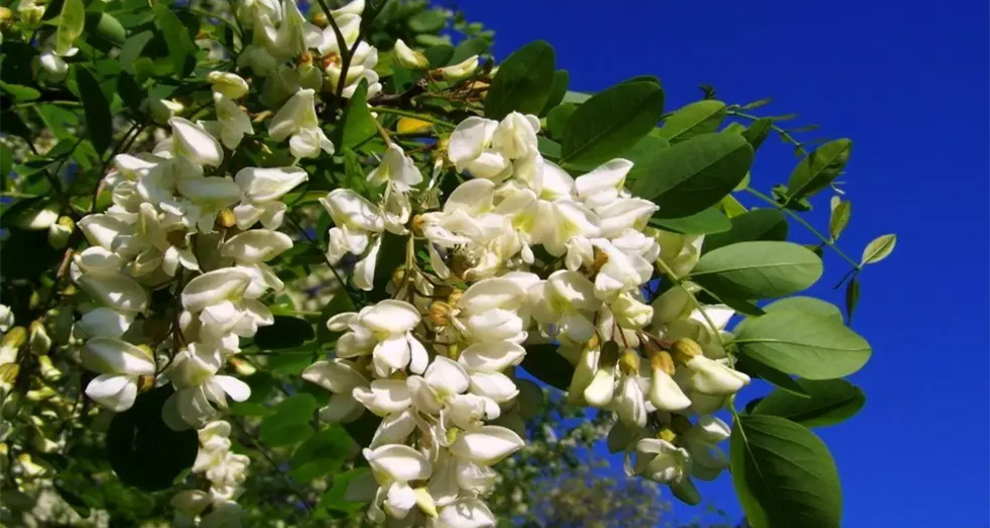
Robinia pseudoacacia Lace Lady, The Twisty Baby black locust, can be found as a shrub and a tree. It reaches a modest height of 20 feet with an equal spread. The Twisty Baby Black Locust grows to five feet when planted in a container. Its distinctive limbs twist and bend, giving it its unique name.
C. Bristly Locust Tree
| Scientific Name | Robinia hispida |
| Hardiness Zone | Varies depending on the specific location, but generally, 4-8
|
| Thorns? | Yes |
| Flowers | Showy rose-colored pea-like flowers in hanging clusters |
| Mature Size | 3 to 10 feet |
Also called the Prickly or Rose Acacia locust, the Bristly locust is a deciduous tree or small suckering shrub. These locust tree species have an ornamental value and are introduced for erosion control.
They are considered invasive in many stages and are mildly poisonous. They have pinnately compound leaves with nine to thirteen elliptical leaflets. Their stems are zigzag and slender, typically covered in bristly red hair.
The tree yields flat pods. They are 2-2.5 inches long and very bristly. Bristly locust thrives in well-drained, moist, sunny, or shaded areas. They reproduce vegetatively via root suckers.
D. Water Locust
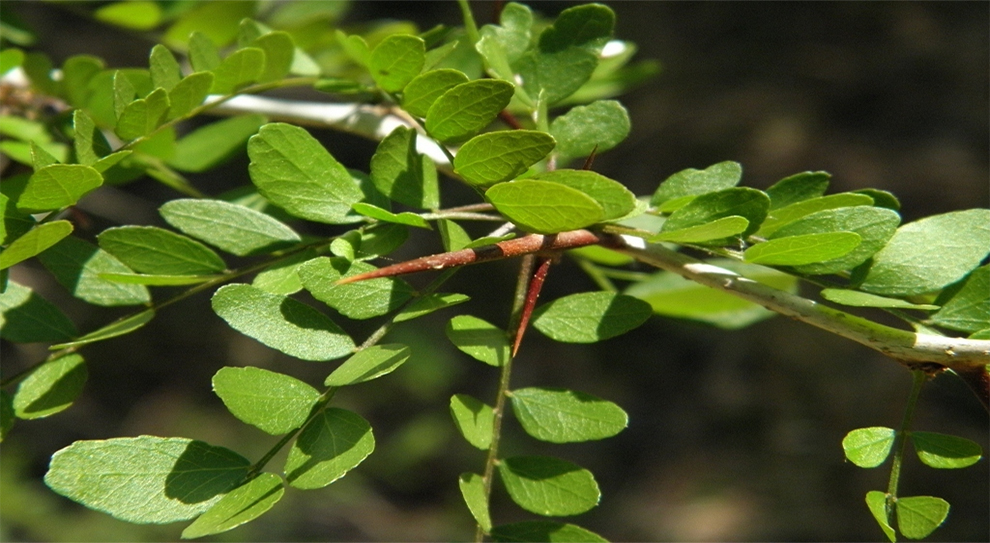
| Scientific Name | Gleditsia caspica |
| Hardiness Zone | Hardiness zones 5 to 9 |
| Thorns? | Long reddish-brown thorns along their branches |
| Flowers | Beautiful and fragrant flowers |
| Mature Size | 40 meters |
Commonly found near waterlogged areas and riverbanks, the Water Locust has a modest height making them ideal for providing shade and serving as a backdrop in mini forests or gardens. They have slender green leaves and thorns that offer protection against leaf consumption by animals.
Water locusts also have almond-shaped reddish-brown pods with pointed tips. Despite their thorny exterior, they have scented flowers.
The Water Locust can thrive in boggy, wet, acidic, alkaline, or neutral soils. They can also adapt to sand, loam, and clay. However, the chalk soils are unsuitable.
E. New Mexico Locust
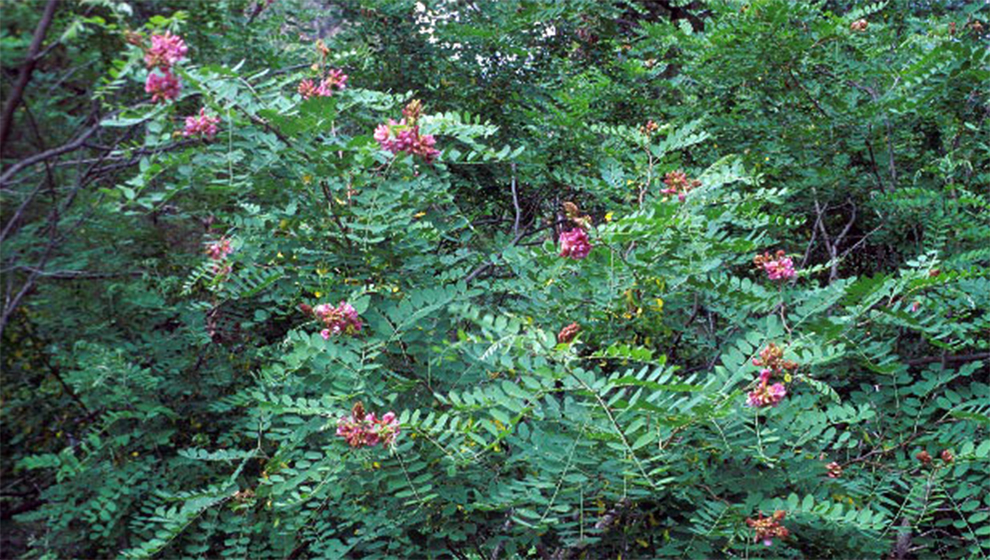
| Scientific Name | Robinia neomexicana |
| Hardiness Zone | Hardiness zones 4 to 8 |
| Thorns? | Thorns along its branches, act as a defensive mechanism |
| Flowers | Dense clusters of beautiful flowers |
| Mature Size | 10 feet |
The New Mexico Locust is spotted in the Southwestern United States. Despite their name, the New Mexico Locusts do not originate from Mexico. These adaptable locust tree varieties can take the form of a tree or a shrub, depending on the conditions it encounters, such as sunlight and soil composition.
With thorns for protection, it showcases stunning clusters of flowers. They have impressive large branches and a dense growth pattern.
You will find them in pure stands in woods and forests. They can rejuvenate a landscape and grow after a fire, courtesy of its solid root sprouting.
Related: Locust Tree Lifespan
What Is The Most Common Locust Tree?
Honey Locust is the most common locust tree. It is a widely planted and cultivated species known for its attractive foliage and endurance to different soil conditions.
What Kind Of Locust Trees Do Not Have Thorns?
Some locust trees that do not have thorns are:
- Black Locust
- Twisty Baby Black Locust
- Clammy Locust
- Bristle Locust
